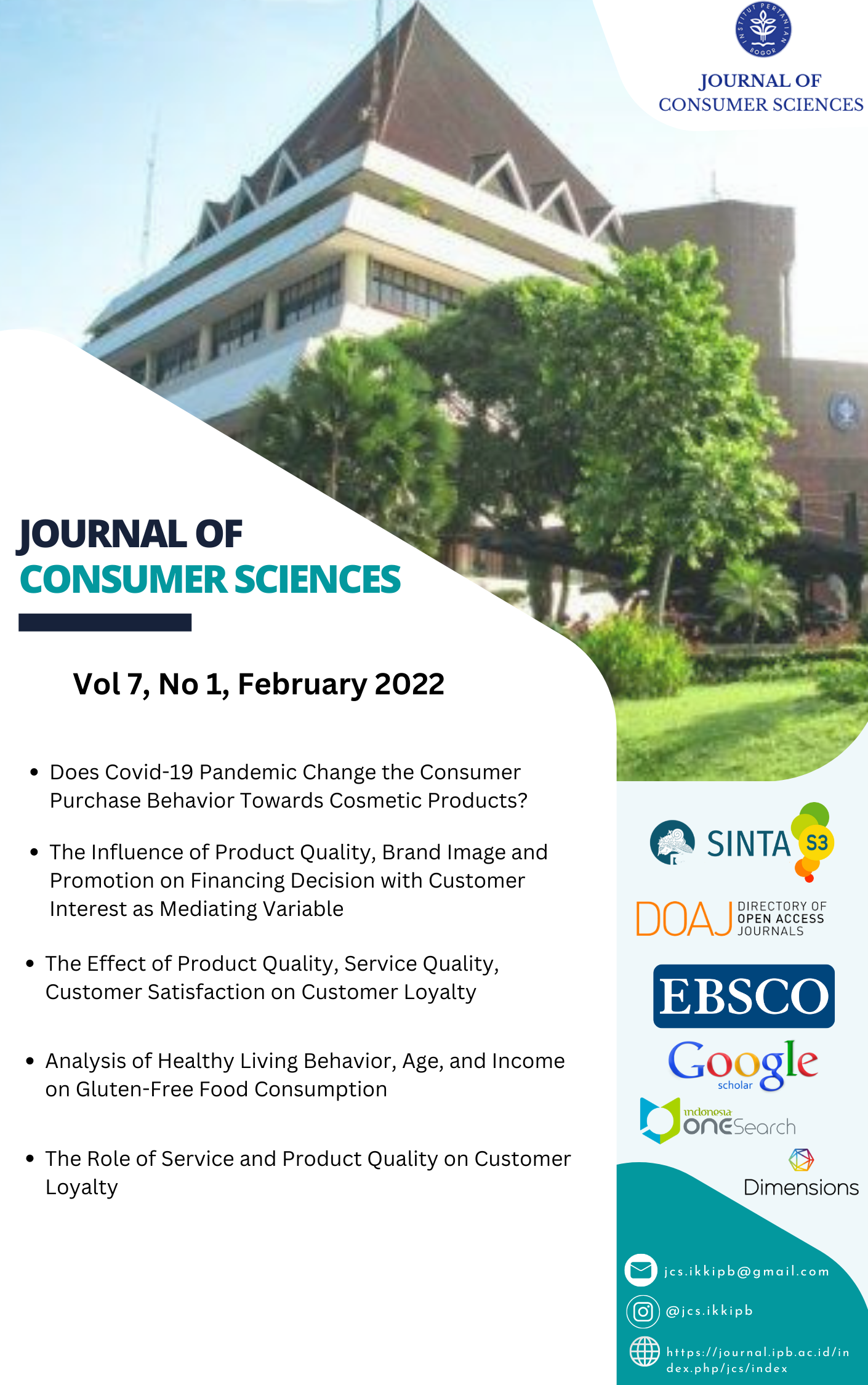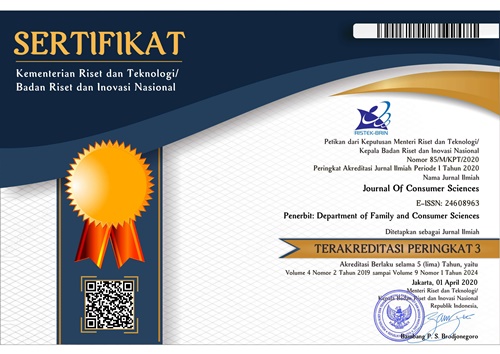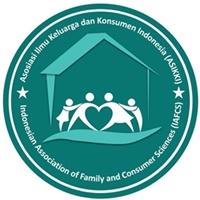Analysis of Healthy Living Behavior, Age, and Income on Gluten-Free Food Consumption
Abstract
This research was triggered by the phenomenon of an increase in people adopting a healthy lifestyle during the COVID-19 pandemic. People who adopt a healthy lifestyle are assumed to consume healthy food such as gluten-free food. Meanwhile, as people grow older and their income improves, the desire to consume gluten-free food also increases. This research aims to analyze healthy behavior, age, and income on the desire to consume gluten-free foods that Logit Model constructed. Gluten-free foods can be defined as foods that do not contain gluten substances such as wheat, and they can be classified as healthy food because people who consume this food can avoid some diseases. The study determined Logit Model and used quantitative methods and convenience sampling based on the SPSS application. From 10 to 12 October 2021, research collected 193 respondents, mainly from the Jabodetabek area. Using Wald Test, the study formed a Logit Model for this relationship. In conclusion, healthy living behavior, age, and income partially and simultaneously influence gluten-free food consumption. By observing this study, entrepreneurs in the food sector are expected to produce gluten-free food.
References
Afina, S., & Retnaningsih, R. (2018). The influence of students’ knowledge and attitude toward functional foods consumption behavior (Pengaruh pengetahuan dan sikap siswa terhadap perilaku konsumsi pangan fungsional). Journal of Consumer Sciences, 3(1), 1-14. doi: https://doi.org/10.29244/jcs.3.1.1-14
Batista, J., Mariano, I. M., Souza, T., Costa, J., Giolo, J., Cheik, N., & Puga, G. (2018). The acute effects of mat pilates on hemodynamic and salivary nitrate responses after exercise in postmenopausal women (Efek akut mat pilates pada respon hemodynamic dan nitrate saliva setelah latihan pada wanita pascamenopause). Journal of Aging and Physical Activity, 27, 1-22. doi: 10.1123/japa.2018-0106
Benzeval, M., Bond, L., Campbell, M., Egan, M., Lorenc, T., Petticrew, M., & Popham, F. (2014). How does money influence health? project report (Bagaimana uang mempengaruhi kesehatan? laporan proyek). New York(US): Joseph Rowntree Foundation.
Bloom, I., Edwards, M., Jameson, K., Syddall, H., Dennison, E., Gale, C., & Robinson, S. (2016). Influences on diet quality in older age: the importance of social factors (Pengaruh kualitas diet pada usia tua: pentingnya faktor-faktor sosial). Age and Ageing, 46(2), 277-283. doi: https://doi.org/10.1093/ageing/afw180
Cabanillas, B. (2020). Gluten-related disorders: Celiac disease, wheat allergy, and non-celiac gluten sensitivity (Gangguan terkait gluten: penyakit celiac, alergi gandum, dan sensitivitas terhadap gluten nonceliac). Critical Reviews in Food Science and Nutrition, 60(15), 2606–2621. doi: https://doi.org/10.1080/10408398.2019.1651689
Çelebi, C., Gündoğdu, C. & Kızılkaya, A. (2017). Determination of healthy lifestyle behaviors of high school students (Penentuan perilaku hidup sehat siswa sekolah menengah atas). Universal Journal of Educational Research, 5(8), 1279-1287. doi: https://doi.org/10.13189/ujer.2017.050801
Chen, P. J., & Antonelli, M. (2020). Conceptual models of food choice: Influential factors related to foods, individual differences, and society (Model konseptual pilihan makanan: faktor-faktor yang berpengaruh terkait makanan, perbedaan individu, dan masyarakat). Foods, 9(12), 1-21. doi: 10.3390/foods9121898
Chrysostomou, S., Andreou, S., & Andreou, Ch. (2019). The development of the gluten free healthy food basket in Cyprus. Is it affordable among low-income adults diagnosed with celiac disease? (Pengembangan kelompok makanan sehat bebas gluten di Siprus. apakah terjangkau oleh orang dewasa berpenghasilan rendah yang didiagnosis mengidap penyakit celiac?). Journal of public health (Oxford, England), 42(2). 270-276. doi: 10.1093/pubmed/fdz034
Cockerham, W., Wolfe, J. D., & Bauldry, S. (2019). Health lifestyles in late middle Age (Gaya hidup sehat di akhir Abad Pertengahan). Sage Journals, 42(1), 34-46. doi: https://doi.org/10.1177/0164027519884760
Czaja-Bulsa, G., & Bulsa, M. (2017). What do we know now about IgE-mediated wheat allergy in children? (Apa yang sekarang kita ketahui tentang alergi gandum bermedia IgE pada anak-anak?). Nutrients, 9(1), 1-9. doi: 10.3390/nu9010035
Dunneram, Y., & Jeewon, R. (2015). Determinants of eating habits among older adults. Progress in Nutrition, 17(4), 274-283
FDA Consumer Health Information/U.S. Food and Drug Administration. (2013). What is gluten free? FDA has an answer. Retrieved from https://www.fda.gov/food/nutrition-education-resources-materials/gluten-and-food-labeling.
Ernawati, H., & Suwandojo, D. P. H. (2019). Consumer preferences for Indonesian culinary (Preferensi konsumen terhadap kuliner Indonesia). Journal of Indonesian Economy and Business, 34(3), 280 – 293. doi: 10.22146/jieb.52637
Ford, K., Hughes, K., Gee, I., McHale, P., Prickett, L., Page, Y., & Bridgman, S. (2014). Guernsey and Alderney healthy lifestyle survey 2013 (Survei gaya hidup sehat Guernsey dan Alderney 2013). Retrieved from https://www.researchgate.net/publication/271512707
French, S. A., Tangney, C. C., Crane, M. M., Wang, Y., & Appelhans, B. M. (2019). Nutrition quality of food purchases varies by household income: the SHoPPER study (Kualitas gizi pembelian makanan bervariasi menurut pendapatan rumah tangga: studi SHOPPER). BMC Public Health, 19:231, 1-7. https://doi.org/10.1186/s12889-019-6546-2
Fry, L., Madden, A., & Fallaize, R. (2018). An investigation into the nutritional composition and cost of gluten-free versus regular food products in the UK (Investigasi komposisi nutrisi dan biaya antara produk makanan bebas gluten dan produk makanan biasa di Inggris). Journal of Human Nutrition and Dietetics, 31(1), 108-120. doi: https://doi.org/10.1111/jhn.12502
Gujral, N., Freeman, H. J., & Thomson, A. B. R. (2012). Celiac disease: prevalence, diagnosis, pathogenesis and treatment (Penyakit celiac: prevalensi, diagnosis, patogenesis dan pengobatan). World J. Gastroenterol, 18(42), 6036–6059. doi: https://dx.doi.org/10.3748/wjg.v18.i42.6036
Hartatin, D., & Simanjuntak, M. (2016). The effect of value and reference group on young consumer’s hedonic buying (Pengaruh nilai dan kelompok referensi pada pembelian hedonis konsumen muda). Journal of Consumer Sciences, 1(1), 33-46. doi: https://doi.org/10.29244/jcs.1.1.33-46
Helldán, A., Lallukka, T., Rahkonen, O., & Lahelma, E. (2011). Changes in healthy food habits after transition to old age retirement (Perubahan kebiasaan makan sehat setelah transisi ke masa pensiun). European Journal of Public Health, 22(4), 582-586. doi: 10.1093/eurpub/ckr060
Jakobsson, J., Malm, C., Furberg, M., Ekelund, U., & Svensson, M. (2020). Physical activity during the coronavirus (COVID-19) pandemic: prevention of a decline in metabolic and immunological functions (Aktivitas fisik selama pandemi virus corona (COVID-19): pencegahan penurunan fungsi metabolisme dan imunologis). Frontiers in sports and active living, 2(57), 1-4. doi: https://doi.org/10.3389/fspor.2020.00057
Jaye, C., Young, J., Egan, R., Llewellyn, R., Cunningham, W., & Radue, P. (2018). The healthy lifestyle in longevity narratives (Gaya hidup sehat dalam narasi umur panjang). Social Theory Health, 16(1), 1-18. doi: 10.1057/s41285-018-0062-9
Kardoko, H. (2020). Revolusi industri farmasi di tengah pandemi Covid-19 (The pharmaceutical industry revolution in the midst of the Covid-19 pandemic). Retrieved from https://ekonomi.bisnis.com/read/20201022/257/1308478/revolusi-industri-farmasi-di-tengah-pandemi-covid-19.
Khoury, D. E., Balfour-Ducharme, S., & Joye, I. (2018). A review on the gluten-free diet: technological and nutritional challenges (Ulasan tentang diet bebas gluten: tantangan teknologi dan nutrisi). Nutrients, 10(10), 1-25. doi: https://doi.org/10.3390/nu10101410
Klieštik, T., Kočišová, K., & Mišanková, M. (2015). Logit and probit model used for prediction of financial health of company (Model logit dan probit untuk memprediksi kesehatan keuangan perusahaan). Procedia Economics and Finance, 23, 850–855. https://doi.org/10.1016/S2212-5671(15)00485-2
Kocak, D. Y. (2017). Effect of pender’s healthy life style training, which is applied in the direction of health promotion model, on eliminating the menopausal symptoms (Pengaruh pelatihan gaya hidup sehat pender yang diterapkan dalam arah model promosi kesehatan dalam menghilangkan gejala menopause). [Doctoral Theses]. Istanbul: Istanbul University.
Lambert, K. & Ficken, C. (2015). Cost and affordability of a nutritionally balanced gluten-free diet: is following a gluten-free diet affordable? (Biaya dan keterjangkauan dari diet bebas gluten yang bergizi seimbang: apakah menjalankan diet bebas gluten terjangkau?). Nutrition & Dietetics; Journal of Dietetians Australia, 73(1), 36-42. doi: 10.1111/1747-0080.12171
Lesakova, D. (2018). Health perception and food choice factors in predicting healthy consumption among elderly (Persepsi kesehatan dan faktor pilihan makanan dalam memprediksi konsumsi sehat di kalangan lanjut usia). Acta Universitatis Agriculturae et Silviculturae Mendelianae Brunensis, 66(6), 1527-1534. doi: 10.11118/actaun201866061527
Lobo, R.A., Davis, S., Villiers, T.D., Gompel, A., Henderson, V., Hodis, H.N., & Baber, R. (2014). Prevention of diseases after menopause (Pencegahan penyakit setelah menopause). Climacteric, 17(5), 540-556. doi: 10.3109/13697137.2014.933411
Lockie, S, K. Lyons, G Lawrence, J. Gricec. (2004). Choosing organics: a path analysis of factors underlying the selection of organic food among australian consumers (Memilih organik: analisis jalur faktor yang mendasari pemilihan makanan organik di antara konsumen Australia). Appetite, 43(2), 135-146. doi: https://doi.org/10.1016/j.appet.2004.02.004
Littlejohns, T.J., Chong, A.Y., Allen, N.E., Arnold, M., Bradbury, K.E., Mentzer, A.J., & Carter, J.L. (2021). Genetic, lifestyle, and health-related characteristics of adults without celiac disease who follow a gluten-free diet: a population-based study of 124,447 participants (Genetik, gaya hidup, dan karakteristik terkait kesehatan orang dewasa tanpa penyakit celiac yang mengikuti diet bebas gluten: sebuah studi berbasis populasi dari 124.447 peserta). The American Journal of Clinical Nutrition, 113(3), 622–629. doi: https://doi.org/10.1093/ajcn/nqaa291
Liu, X., Luo, W. T., Li, Y., Li, C. N., Hong, Z. S., Chen, H. L., ... Xia, J. Y. (2020). Psychological status and behavior changes of the public during the COVID19 epidemic in China (Status psikologis dan perubahan perilaku masyarakat selama epidemi COVID-19 di Cina). Infectious Diseases of Poverty, 9(58), 1-11. doi: https://doi.org/10.1186/s40249-020-00678-3
Markets and Markets. (2021). Gluten-free products market by type (bakery products, snacks & rte products, condiments & dressings, pizzas & pastas), distribution channel (conventional stores, specialty stores and drugstores & pharmacies), form & region - global forecast to 2025. Retrieved from https://www.marketsandmarkets.com/Market-Reports/gluten-free-products-market-738.html.
Pinto-Sanchez, M. I. & Verdu, E. F. (2018). Non‐celiac gluten or wheat sensitivity: it’s complicated! (Sensitivitas gluten atau gandum non-celiac: rumit!). Neurogastroenterology & Motility, 30(8), e13392. doi: 10.1111/nmo.13392
Marmot, M. (2002). The influence of income on health: views of an epidemiologist (Pengaruh pendapatan terhadap kesehatan: pandangan seorang ahli epidemiologi). Health Affairs, 21(2), 31-46. doi: 10.1377/hlthaff.21.2.31
Masih, J. & Sharma, A. (2016). Study on consumer behaviour and economic advancements of gluten-free products (Studi perilaku konsumen dan kemajuan ekonomi produk bebas gluten). American Journal of Experimental Agriculture, 12(1), 1-10. doi: 10.9734/AJEA/2016/24737
Ministry of Health of the Republic of Indonesia. (2020). Guidelines for the prevention and control of the corona virus disease (Covid 19) revised 4th. Jakarta: Directorate General of Disease Prevention and Control.
Morris, J., Wilkinson, P., Dangour, A. D., Deeming, C., & Fletcher, A. (2007). Defining a minimum income for healthy living (MIHL): older age, England (Mendefinisikan pendapatan minimum untuk hidup sehat (MIHL): usia yang lebih tua, Inggris). International Journal of Epidemiology, 36(6), 1300-1307. doi: https://doi.org/10.1093/ije/dym129
Morris, J. N., Donkin, A. J. M., Wonderling, D., Wilkinson, P., & Dowler, E.A. (2000). A minimum income for healthy living (Penghasilan minimal untuk hidup sehat). Journal of Epidemiology and Community Health, 54(12), 885-889. doi: http://dx.doi.org/10.1136/jech.54.12.885
Motegi, H., Nishimura, Y., & Terada, K. (2016). Does retirement change lifestyle habits? (Apakah pensiun mengubah kebiasaan gaya hidup?). The Japanese Economic Review, 67(2), 169-191. doi: 10.1111/jere.12104
Myhrstad, M. C., Slydahl, M., Hellmann, M., Garnweidner-Holme, L., Lundin, K. E. A., Henriksen, C., & Telle-Hansen, V. H. (2021). Nutritional quality and costs of gluten-free products: a case-control study of food products on the Norwegian marked (Kualitas nutrisi dan biaya produk bebas gluten: studi kasus produk makanan berlabel Norwegia). Food & Nutrition Research, 65:6121, 1-10. doi: https://doi.org/10.29219/fnr.v65.6121
Nugroho, H.P., & Nikmah, F. (2018). Pengaruh gaya hidup dan positive word of mouth terhadap keputusan pembelian produk tepung bebas gluten Ladang Lima (The influence of lifestyle and positive word of mouth on purchasing decisions of Ladang Lima gluten-free flour products). Jurnal Aplikasi Bisnis, 4(2), 509-513. E-ISSN: 2407-5523.
Perrin, L., Allès, B., Buscail, C., Ravel, C., Hercberg, S., Julia, C., & Kesse-Guyot, E. (2019). Gluten-free diet in french adults without coeliac disease: sociodemographic characteristics, motives and dietary profile (Diet bebas gluten pada orang dewasa perancis tanpa penyakit celiac: karakteristik sosiodemografi, motif, dan profil diet). British Journal of Nutrition, 122(2), 231–239 doi:10.1017/S0007114519001053.
Redata, L., Kezia, R., Solaiman, K.H, & Santoso, S. (2021). Analisis korelasi pendampingan komunitas terhadap inovasi pelaku ekonomi kreatif dan pemenuhan kebutuhan konsumen: Studi kasus pada komunitas tangerang berdaya dan pelaku ekonomi kreatif kuliner Tangerang (Correlation analysis of community assistance on creative economy actors' innovation and meeting consumer needs: A case study on the empowered Tangerang community and Tangerang's culinary creative economy actors). Business Management Journal, 17(1), 1-19. doi:10.30813/bmj
Rusilowati, U. (2020). Praktek manajemen sumber daya manusia selama pandemi covid-19 pada karyawan yang bergerak di sektor formal di Indonesia (Human resources management practices during the Covid-19 pandemic on employees moving in the formal sector in Indonesia). Jurnal Ilmiah MEA (Manajemen, Ekonomi dan Akuntansi), 4(2), 481-491. doi: https://doi.org/10.31955/mea.vol4.iss2.pp481-491
Sabença, C., Ribeiro, M., Sousa, T. de, Poeta, P., Bagulho, A. S., & Igrejas, G. (2021). Wheat/gluten-related disorders and gluten-free diet misconceptions: a review (Gangguan terkait gandum/gluten dan kesalahpahaman diet bebas gluten: sebuah tinjauan). Foods, 10(8), 1765. Doi: 10.3390/foods10081765
Šálková, D. & Hes, A. (2015). Gluten-free food - the influence of selected qualitative characteristics on consumer decision making of coeliacs in hospitality establishments (Makanan bebas gluten - pengaruh pemilihan karakteristik kualitatif pada pengambilan keputusan konsumen celiac di perusahaan perhotelan). Czech Journal of Food Sciences, 33(6), 513-517. doi: 10.17221/113/2015-CJFS
Santoso, S. (2010). Model logit (logistic regression) sebagai model probabilitas linier alternatif, dalam contoh aplikasi teknik industri (logistic regression as an alternative linear probability model, in the example of industrial engineering applications). Jurnal Teknik Industri, 2(1), 59-64. doi: https://doi.org/10.22219/JTIUMM.Vol2.No1.59-64
Santoso, S. (2020). Optimizing access to financial capital of creative economy for startups towards global competitiveness (Optimalisasi akses modal finansial ekonomi kreatif untuk startup menuju daya saing global). BECOSS (Business Economic, Communication, and Social Sciences), 2(2), 13-21. doi: https://doi.org/10.21512/becossjournal.v2i2.6246
Santoso, S., Natanael, A., Griselda, A., Khoirunnisa, J., Simanjuntak, M., Bagus, R., & Fatmawati, A. (2021). Analisis pengembangan platform ekspor sub sector kuliner tinjauan dari model sistem inovasi Analysis of the development of the culinary sub-sector export platform, an overview of the innovation system model). Jurnal Distribusi, 9(1), 29-38. doi: 10.29303/distribusi.v9i1.151
Santoso, S., Natanael, A., Griselda, A., Khoirunnisa, J., Simanjuntak, M., Bagus, A., & Merry, L. Z. (2021). Analysis of business process reengineering and export platform in supporting business exports of creative economy players in the micro, small and medium business in culinary sub-sector (Analisis rekayasa ulang proses bisnis dan platform ekspor dalam mendukung ekspor usaha pelaku ekonomi kreatif pada usaha mikro, kecil, dan menengah sub sektor kuliner). Journal of Economics, Business, and Government Challenges (JoEBGC), 4(1), 32-49. doi: 10.33005/ebgc.v4i1.170
Sugiyono. (2017). Statistika untuk Penelitian [Statistics for Research]. Bandung(ID): Penerbit Alfabeta.
Sutanto, L., Lukito, W., & Basrowi, R. W. (2020). Nutrition interventions for healthy ageing in Indonesia (Intervensi nutrisi untuk penuaan yang sehat di Indonesia). Amerta Nutrition, 4(1), 1-5. doi: 10.20473/amnt. v4i1SP.2020.1-5 1
Syah, A., & Yuliati, L. N. (2017). The influence of values and attitude toward healthy food selection at student of Bogor Agricultural University (Pengaruh nilai dan sikap terhadap pemilihan makanan sehat pada mahasiswa Institut Pertanian Bogor). Journal of Consumer Sciences, 2(2), 57-65. doi: https://doi.org/10.29244/jcs.2.2.57-65
Viscecchia, R., Stasi, A., Nardone, G., Devitiis, B. D., & Baselice, A. (2016). Supplements consumption, health oriented behaviour and beyond (Konsumsi suplemen, perilaku berorientasi kesehatan dan seterusnya). Rivista Economia Agraria, 71(1), 256-265. doi: https://doi.org/10.13128/REA-18645
Wielsøe, M., Berthelsen, D., Mulvad, G., Isidor, S., Long, M., & Bonefeld-Jørgensen, E. C. (2021). Dietary habits among men and women in West Greenland: follow-up on the ACCEPT birth cohort (Kebiasaan diet di antara pria dan wanita di West Greenland: tindak lanjut pada kelompok kelahiran ACCEPT). BMC Public Health, 21:1426, 1-17. doi: https://doi.org/10.1186/s12889-021-11359-7
World Health Organization (WHO). Regional Office for Europe. (1999). Healthy living: what is a healthy lifestyle? (Hidup sehat: apa itu gaya hidup sehat?). WHO Regional Office for Europe, Copenhagen. Retrieved from https://apps.who.int/iris/handle/10665/108180.
Zoumpopoulou, G & Tsakalidou, E. (2019). The role of alternative and innovative food ingredients and products in consumer wellness chapter 8, pages 213-237 (Peran bahan dan produk makanan alternatif dan inovatif dalam kesehatan konsumen bab 8). San Diego: Academic Press. Doi: https://doi.org/10.1016/B978-0-12-816453-2.00008-5
Authors who publish with this journal agree to the following terms:
- Authors retain copyright and grant the journal right of first publication with the work simultaneously licensed under a

This work is licensed under a Creative Commons Attribution 4.0 International License. that allows others to share the work with an acknowledgement of the work's authorship and initial publication in this journal. - Authors are able to enter into separate, additional contractual arrangements for the non-exclusive distribution of the journal's published version of the work (e.g., post it to an institutional repository or publish it in a book), with an acknowledgement of its initial publication in this journal.
- Authors are permitted and encouraged to post their work online (e.g., in institutional repositories or on their website) prior to and during the submission process, as it can lead to productive exchanges, as well as earlier and greater citation of published work (See The Effect of Open Access).











